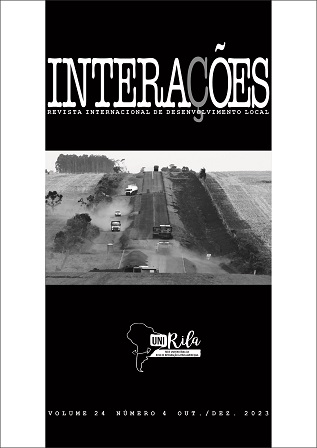Tourism research network: connections, prospects and challenges for sustainability in the Latin American Integration Route
Keywords:
network, tourism, Latin America, sustainability., conec, connectionsAbstract
The present work aims to present the connections of the links of the Tourism and Local Development axis, in order to highlight the mesh and the dynamicity of a network that emerges in the field of potential interactions of UniRila (University Network of the Latin American Integration Route ), woven by researchers and partners who work in the investigation of tourism and local development in the region of the Latin American Integration Route, also known as the Bioceanic Route. For the analysis, the links (social actors), institutional partnerships, products and type of activity of the Tourism Research Network on the Latin American Integration Route in the period from 2018 to 2020 were considered. For the graphical representation of the Network, the program NodeXL Basic Framework 3.5 was used. In this network fabric, everything is social and the links are characterized by social actors/people (researchers, academics, local tourism professionals or professionals from the common territory) active in the Latin American Integration Route. In all, 16 social products resulting from cooperative actions among 24 institutions were identified. The connections are the social relationships between these actors and the existing flows are related to the social products resulting from these relationships, such as projects, research, articles and other actions such as lives via computer networks, workshops and seminars related to tourism in the Latin-American Integration Route.
References
AMARAL, V. Centralização, descentralização e distribuição. Entre Todos, [s.l.], 2016a. Disponível em: https://entrenostodos.wordpress.com/2016/09/21/centralizacao-descentralizacao-e-distribuicao/. Acesso em: 20 abr. 2023.
AMARAL, V. Redes operativas. Entre Todos, [s.l.], 2016b. Disponível em: https://entrenostodos.wordpress.com/2016/09/14/redes-operativas/. Acesso em: 20 abr. 2023.
AMARAL, V. L. Redes: uma nova forma de atuar. In: SEMINÁRIO ESTRATÉGIAS DE SUSTENTABILIDADE, Campo Grande, MS. Anais [...]. Campo Grande, MS, 2005. p. 5-11.
AMARAL, V. L.; OLIVEIRA, G. P.; JUNQUEIRA, V. Educação ambiental e articulação em rede nos corredores de biodiversidade: aprendizagem, interação social, comunicação. In: JUNQUEIRA; V.; NEIMAN, Z. (Org.). Educação Ambiental e Conservação da Biodiversidade. 1. ed. Barueri: Manole, 2007. v. 1. p. 299-309.
ASATO, T. A. CONSTANTINO, M.; DORSA, A. C.; MARIANI, M. A. Rota de Integração Latino-Americana (RILA) para o desenvolvimento turístico. Interações, Campo Grande, MS, v. 20, n. especial, p. 45-56, 2019.
ASATO, T. A.; GONÇALVES, D. F.; WILKE, E. P. Perspectivas do Corredor Bioceânico para o Desenvolvimento Local no estado de MS: o caso de Porto Murtinho. Campo Grande, MS, v. 20, n. especial, p. 141-157, 2019.
FERREIRA, M. L.; CASTILHO, M. A.; OLIVEIRA, E. Brasil, Paraguai, Argentina e Chile / Rota Bioceânica: relações culturais no território vivido. Interações, Campo Grande, MS, v. 20, n. especial, p. 69-89, 2019.
LEVY, P. O que é virtual. São Paulo: Ed. 34. 1996.
MAMEDE, S. B.; SILVA, M.B. Entre o caórdico e o emancipatório: desafios para a formação de redes de educação ambiental no Cerrado brasileiro. In: SANTOS, V. J., NEIMAN, Z. (Org.). Educação ambiental e conservação da biodiversidade: experiências brasileiras. São Paulo: Manole, 2006. p. 287-98.
MARTINHO, C.; FELIX, C. Vida em rede: conexões, relacionamentos e caminhos para uma nova sociedade. São Paulo: Instituto C&A, 2011.
MORIN, E. Ciência com consciência. 8. ed. Rio de Janeiro: Bertrand Brasil, 2005.
PISANI, F. Redes como padrão unificador da vida envolvendo diferentes processos em diferentes níveis: uma entrevista com Fritjof Capra. International Journal of Communication 1, [s.l.], 2007. Disponível em: https://st3.ning.com/topology/rest/1.0/file/get/99216789?profile=original. Acesso em: 20 abr. 2023.
Downloads
Published
How to Cite
Issue
Section
License
Copyright (c) 2023 Simone Mamede, Vivianne Amaral, Maristela Benites

This work is licensed under a Creative Commons Attribution 4.0 International License.
Direitos Autorais para artigos publicados nesta revista são do autor, com direitos de primeira publicação para a revista. Em virtude de aparecerem nesta revista de acesso público, os artigos são de uso gratuito, com atribuições próprias, em aplicações educacionais e não-comerciais.


